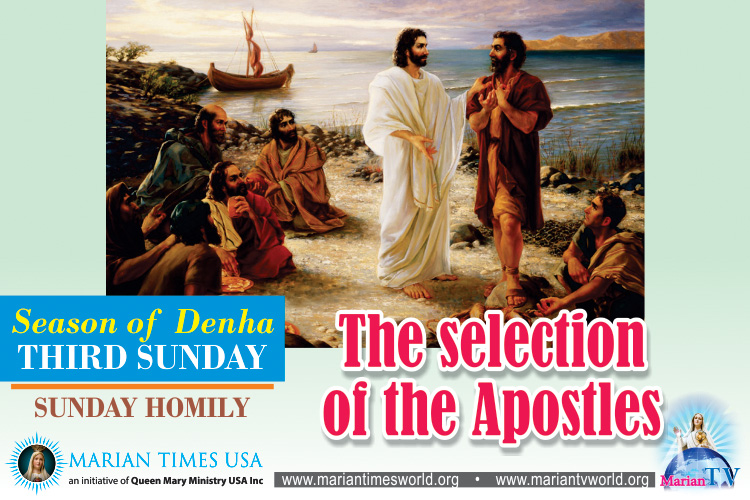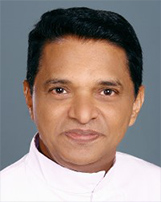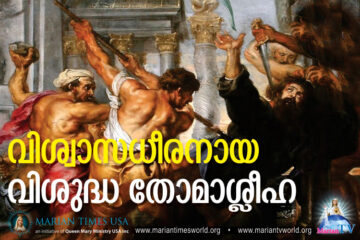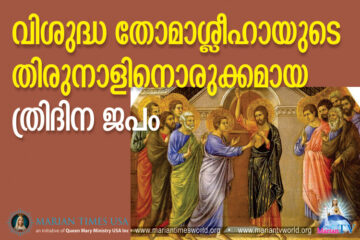The selection of the Apostles (Sunday Homily)


~ Fr. Abraham Mutholath ~
Chicago, USA. ~
Season of Denha
THIRD SUNDAY: Mark 3:7-19
INTRODUCTION
Jesus started his ministry primarily in the synagogues of Galilee, where people assembled for prayer on the Sabbath. The elite Jews,especially the Pharisees and the Scribes, questioned his progressive approach to Sabbath observance,alleged him of blasphemy, andcondemned him for dining with sinners. When the Pharisees plotted to kill Jesus, he moved his ministry from a synagogue to the shore of the Sea of Galilee.He gained wide popularity because of his miracles of healing. People from all over Galilee, Judea, and neighboring regions came to him to cure and to hear his teachings of hope. Jesusused a boat for preachingto avoid the crowd crushing on him. Besides preaching, Jesus healed the sick and cast out demons. After spending a night in prayer on a mountain, he selected 12 disciples as a special team and appointed them as his apostles. Bishops are the successors of these apostles. Under their pastoral guidance in the church, let us grow in faith and give witness to Jesus in our given situation.
BIBLE TEXT (MARK 3:7-19)
The Mercy of Jesus
(Mk 3:7) Jesus withdrew toward the sea with his disciples. A large number of people [followed] from Galilee and from Judea. (8) Hearing what he was doing, a large number of people came to him also from Jerusalem, from Idumea, from beyond the Jordan, and from the neighborhood of Tyre and Sidon. (9) He told his disciples to have a boat ready for him because of the crowd, so that they would not crush him. (10) He had cured many and, as a result, those who had diseases were pressing upon him to touch him. (11) And whenever unclean spirits saw him they would fall down before him and shout, “You are the Son of God.” (12) He warned them sternly not to make him known.
The Mission of the Twelve
(Mk 3:13) He went up the mountain and summoned those whom he wanted and they came to him. (14) He appointed twelve [whom he also named apostles] that they might be with him and he might send them forth to preach (15) and to have authority to drive out demons: (16) [he appointed the twelve:] Simon, whom he named Peter; (17) James, son of Zebedee, and John the brother of James, whom he named Boanerges, that is, sons of thunder; (18) Andrew, Philip, Bartholomew, Matthew, Thomas, James the son of Alphaeus; Thaddeus, Simon the Cananean, (19) and Judas Iscariot who betrayed him.
INTERPRETATION
Background
According to Mark, Jesus performed several miraculous healings. Since he did many of them on the Sabbath, the conservative Jewsinterrogatedhim. The eventsprior to the section we reflect here are:(1) Jesus cured a demoniac on the Sabbath in a synagogue at Capernaum (Mk 1:21-26) whichsparked his fame everywhere in Galilee (Mk 1:28). (2) Jesus cured the fever of Simon’s mother-in-law on the same sabbath day (Mk 1:29-31). (3) On the evening of that day,he healed the sick and demoniacs in the presence of all the villagers (Mk 1:32-34). (4) Jesus went to synagogues allover Galilee preaching and driving out demons (Mk 1:39).(5) He healed a leper (Mk 1:40-45). (6) When some brought down a paralytic opening the rooftop of a crowded room at Capernaum, Jesus forgave the sins of the paralytic along with his healing. The scribes accused Jesus of blasphemy for forgiving the sins (Mk 2:1-12). Jesus called Levi at the customs post and dined at his house with his friends. The Scribes and Pharisees questioned Jesus for eating with sinners and tax collectors (Mk 2:13-17).The people questioned Jesus for ignoring the non-practice of fasting by his disciples (Mk 2:18-22). The Pharisees interrogated Jesus for his disciples’picking the heads of grains, grinding,and eating them,which violatedthe sabbath (Mk 2: 23-28). While the Pharisees were critically observing Jesus, he healed a man’s withered hand on the Sabbath (Mk 3:1-6). This agitated them and they “went out and immediately took counsel with the Herodians against him to put him to death” (Mk 3:1-6). Though the public highly admired Jesus, the Pharisees, Scribes, and Herodians allegedhim of violating Sabbath, for allowing his disciples to do the same, and being blasphemous. Their agitation was so high that they plotted to kill him as perthe Jewish law.
The Mercy of Jesus
(Mk 3:7) Jesus withdrew toward the sea with his disciples. A large number of people [followed] from Galilee and from Judea.
Jesus withdrew toward the sea with his disciples.
Where was Jesus before he withdrew to the seashore? The immediate cause for this move was the assassination planningof the Pharisees when Jesus healed a man’s withered hand on the Sabbath (Mk 3:1-6). Then “the Pharisees went out and immediately took counsel with the Herodians against him to put him to death” (Mk 3:6). So, the location must be a center of Pharisees and Herodians. Though Capernaum was the center of Jesus’ ministry while he was in Galilee, thiscrisis must have occurred in Sepphoris, the provincial capital of Herod Antipas. It is about four miles (six km.) northwest of Nazareth, and about 15 miles (25 km.) from the Sea of Galilee.That was a Jewish center with many Pharisees and Herodians living there.
Jesus and the Jewish leaders differed in their views on sabbathobservance. For Jesus, the acts of mercy were part of worship, allowable on the Sabbath,and in congruence with the spirit of the Law. The leaders differedwith this. To avoid confrontation with them at an early stage, when his hour had not yet reached, Jesus moved out of the synagogue. This was not out of fear, but to avoid his immediate assassination in Galilee. His self-sacrifice should happen in Jerusalem, and not in Galilee. Jesus had withdrawn from the public frequently in Mark to escape from enemies (Mk 3:7), to pray (Mk 1:12; 6:46; 14:32-33), for rest (Mk 6:31; 7:24; 7:31; 10:1), and for private discussions with his disciples (Mk 7:17; 9:2).
Fleeing from place to place because of persecution was tolerable for Jesus because he does not want Christians to fight against their opponents or throw themselves unnecessarily into danger. The disciples should continue their mission rather than facing an untimely martyrdom from the enemies. So, Jesus had advised his disciples, “When they persecute you in one town, flee to another” (Mt10:23).
Jesus withdrew toward the sea with his disciples.
The sea mentioned here is the Sea of Galilee,that is in fact a lake. Its other names are Lake of Gennesaret and Lake Tiberias. This pear-shaped lake is the lowest freshwater lake on the earth. Ithasa circumference of 33 miles with mountains around it. Its beaches and valleys with hills in the back all aroundmade it convenient for the crowd to gather like in an amphitheater,while Jesus preachedon a boat. It provided amplifyingsound effect for his speech when there were no artificial devices for sound amplification.
Jesus withdrew toward thesea with his disciples.
When Jesus became popular, he got disciples who followed him to listen to him and to witness the miracles he performed. Luke records that “a great crowd of his disciples” (Lk 6:17) followed him.
A large number of people [followed]
Though the reason for Jesus’ move from the synagogue to the lakeshore was the resentment of the Pharisees, he had the advantage of accommodating the enormous crowd on the open ground that no synagogue could contain. The Gentiles,Publicans, and others who were ineligible, or uninterested in the synagogue service,could also meet Jesus at the lakeshore. Besides, he could avoid the disturbance of the antagonists in the synagogue.
Jesus was popular only by word of mouth because no print or electronic media was available for publication. Ordinary people had to walk miles to reach Jesus. This was especially difficult for the sick and those who had to carry them. Besides the people in Galilee,manyarrived from the neighboring cities. Mark mentions their names.Such aflow of people shows the wide popularity Jesus had gained because of hismerciful miracles.
from Galilee
During the public ministry of Jesus, Palestine had three traditional regions:Galilee in the north, Judea in the south, and Samaria in between them. Jesus’ ministry was mainly in Galilee and Judea. Since the conservative Jews, the Sanhedrin, and the Temple were in Judea, Jesus’s life was at threat there. So,he centered his ministryat Capernaum in Galilee.
Joshua had assigned Galilee to Asher, Naphtali, and Zebulun tribes when the Israelites first inhabited the Promised Land. Zebulun and Naphtali tribes failed toexpelentirely the native Canaanites when they entered the land. So, they later had Gentile influence and attacks from neighboring Gentiles. The Assyrians conquered the land, exiled many Israelites in 733 BC, and scattered them so they would not unite for any revolt against the Assyrians. Many foreigners then settled in the land. So, Galilee became a mixed group of Israelites and Gentiles. Aristobulushad conquered Galilee for the Jews in 104 BC and forcibly made the inhabitants Jews through circumcision.
The name Galilee had derived from the Hebrew word “galil,” that means circle. The full name was the Galilee of the Gentiles. The Gentiles lived around them as neighbors: the Phoenicians in the west, Syrians in the north and east, and Samaritans in the south. Since the Gentiles and Jews lived around Galilee, the Jews there were open to innovative ideas compared to Judea. So, Jesus had better receptivity from the Jews and Gentiles in Galilee.
and from Judea
Judea is the southern region of Palestine adjoining Jerusalem,where the Jewsre-inhabited after their return from Babylonian captivity. Samaria surrounded itin the North, Jordan in the east, Mediterranean Sea in the west, and the town of Beersheba in the south.When the Israelites conquered Canaanites and settled in Palestine, predominantly the tribe of Judah had settled there. Later, King David captured Jerusalem in the tenth century BC from the Jebusites andmade it the capital of the unified 12 tribes of Israel. After his son King Solomon’s death, the northern 10 tribes separated from Judea, and Jerusalem continued to be the capital of Judea.Jesus used to go to the Jerusalem Temple for feasts and preached there as well. Because of the wide popularity of Jesus, people from all over Judea also came to Galilee to listen to him.
(8) Hearing what he was doing, a large number of people came to him also from Jerusalem, from Idumea, from beyond the Jordan, and from the neighborhood of Tyre and Sidon.
Hearing what he was doing,a large number of people came to him
Jesus performed more miracles than all the previous prophets combined. They were mostly acts of mercy for the marginalized people. That attracted a massive amount of people to meet Jesus in person. They were eager to benefit fromwhat he was doing and listen to his progressive ideas of hope for the less fortunate in the community.
Also from Jerusalem
Jerusalem was the capital of the united Israel and later of Judea. The Temple was located there. The presence of the elite Jews, especially the Sanhedrin, was a hurdle for Jesus because he challenged their corruption and the undue importance they gave to man-made traditions that were inconsistent with the genuine spirit of the precepts of God through Moses. Mark specifies Jerusalem to highlight that even people from the Jewish headquartersof Judea also came to listen to Jesus. They had to travel around hundredmiles from Jerusalem to reach Capernaum.
From Idumea
The descendants of Esau, called Edomites, had settled in Idumea. Edom in Hebrew means red. Like Esau, who was reddish (Gen 25:25), the region they occupied had sandstone cliffs in red color. It was south of Judea and the Dead Sea. During the Babylonian captivity, the Edomites occupiedsome areas in the south of Palestine. They mingled with the Jews and practiced circumcision. King Herod the Great was a descendant of this mixed race.They also showed interest in the message and activities of Jesus. Hence, they came all the way from the southto Capernaum to listen to him.
From beyond the Jordan
Beyond Jordan means those who lived on the east side of River Jordan across Palestine.
From the neighborhood of Tyre and Sidon
Tyre and Sidonare in the north of Galilee, now in Lebanon. The inhabitants of Sidon must be the descendants of Sidon, who was the firstborn son of Canaan, the grandson of Noah (Gen 10:15). Sidon was the northern border of the ancient Canaanites (Gen 10:19). Tyre is 20 miles south of Sidon on a rock island on the east coast of the Mediterranean Sea. The name Tyre came from the Semitic word “Sister” meaning rock.
Though Joshua had allotted Tyre and Sidon also to the tribe of Asher (Josh 19:28-29) at the conquest of Canaan, the Israelites never conquered the inhabitants there (Judg 1:31-32). “So the Israelites lived in the midst of the Canaanites, Hittites, Amorites, Perizzites, Hivites and Jebusites. The Israelites married the daughters of these people, gave their own daughters in marriage to the sons of these people and served their gods” (Judg 3:5-6).
Tyre contributed supplies and personnel for the construction of David’s palace in Jerusalem (2 Sam 5:11) and for the Temple. “The Sidonians and Tyrians had brought cedar logs to David in great quantities” (1 Chr 22:4).
The Assyrians attacked the ten northern tribes of Israel around 740 BC and exiled them to various parts of their empire. The tribe of Asher was also among the lost 10 tribes. Jeremiah (27:3-11) and Ezekiel (26:7-14) had prophesied the surrender of Tyre andSidon to Nebuchadnezzar. The Babylonian King Nebuchadnezzar besieged Tyre for 13 years (585 BC).
After returning from the Babylonian exile, when the Jews started construction of the second Temple in Jerusalem (521-516 BC) under the leadership of Zerubbabel, they sought help from Tyre and Sidon for construction materials and personnel for the Temple. “They gave money to the masons and the carpenters. They also gave food, wine and oil to the Sidonians and Tyrians to bring cedar trees from Lebanon to Joppa by sea, according to the authorization of Cyrus, king of Persia” (Ezra 3:7).
The people from the neighborhood of Tyre and Sidon also joined the crowd at the lakeshore of the Sea of Galilee to listen to Jesus. That might have been the reason for the Syro-Phœnician woman to seek Jesus’s help for healing her daughter (Mt 15:21-28; Mk 7:24-30). She addressed Jesus as the Son of David (Mt 15:22) professingher faith in Jesus as the Messiah. She could also be one among the crowd at the Sea of Galilee to listen to Jesus.
(9) He told his disciples to have a boat ready for him because of the crowd, so that they would not crush him.
He told his disciplesto have a boat ready for him because of the crowd
Some disciplines of Jesus were fishermen, and the boats they had used must have been available then. So, he asked them to arrange a boat that he could use as a platform to address the vast crowd without them crushing on him. He used a natural crowd control system that would keep the crowd at a safe distance from the speaker.
So that they would not crush him
When the crowd is too large, the sick and their helpersmight worry about getting personal attention and cure from Jesus.So, they kept pressing on him. That was dangerous for Jesus and the people around. The crowd might step or fall on those who were in front of them because of the wave of push coming from behind.
The primary goal of Jesus was to preach the gospel and prepare the people for the new kingdom that he was going to inaugurate on the day of Pentecost. His second priority was to help those who were in misery, making use of his divine power. Providing acts of mercy without conveying the gospel message should not be the Christian missionary goal. However, his listeners had the freedom to accept or decline his message and bear the consequences.
(10) He had cured many and, as a result, those who had diseases were pressing upon him to touch him.
He had cured many
The chief attraction of the immense crowdthat came from all the neighboring localities was Jesus’ power and willingness to heal even the incurable diseases. There was no report like that ever before.
those who had diseases were pressing upon him to touch him.
The sick people were eager to get healing from Jesus. Because a vast crowd came even from faraway places, the sick persons and their families were competing to get his attention. They tried to touch Jesus,believing they could get healed by doing so.
There were several instances when people got healing by touching Jesus’cloak. While Jesus was going to an official’s house to heal his daughter, a woman who had a hemorrhage for 12 yearscame up behind him and touched the tassels on his cloak. “She said to herself, ‘If only I can touch his cloak, I shall be cured’” (Mt 9:21). She might have heard of such miracles of Jesus happening before.When she did so in secret, “Immediately her flow of blood dried up. She felt in her body that she was healed of her affliction” (Mk 5:29). When Jesus reached Gennesaret with his disciples, the people there recognized him.“They sent word to all the surrounding country. People brought to him all those who were sick and begged him that they might touch only the tassel on his cloak, and as many as touched it were healed” (Mt 14:35-36; Mk 6:56).
(11) And whenever unclean spirits saw him they would fall down before him and shout, “You are the Son of God.”
Whenever unclean spirits saw him
Popular belief of the time was that evil spirits enter the body of living persons causing mentalor certain physical illness. The person convinced of such a possession identified with the evil spirit and behaved like that demon.
They would fall down before him
The demons were bowing not to express homage to Jesus as the Son of God. They fell down because of their powerlessness in front of Jesus, and they were afraid that he might cast them out from the afflicted people. Even ifthe demons were the real ones, they were afraid that the Messiah might cast them out to the abyssbefore the appointed time (Mt 8:29) which would take place only at his second coming (Rev 20:1-10).
Shout, “You are the Son of God.”
Though the Bible used “Son of God” only for Jesus in the strict sense, it was used also for:
1.Angels: “One day, when the sons of God came to present themselves before the LORD, the satan also came among them (Job 1:6).”
2.The chosen or righteous people: “The sons of God saw how beautiful the daughters of human beings were” (Gen 6:2).
3.The Nation of Israel: “When Israel was a child I loved him, out of Egypt I called my son” (Hosea 1:1), “Thus says the LORD: Israel is my son, my firstborn” (Ex 4:22).
4.The king of Israel: “I will be a father to him, and he shall be a son to me” (2 Samuel 7:14).
5.Those who show mercy to others: “Be like a father to orphans, and take the place of a husband to widows. Then God will call you his child” (Sirach 4:10).
However, the “Son of God,” when used for Jesus,is different because he shares the essence of God from eternity. All other sons of God, like Adam,are God’s creation.
Jesus acknowledgedwhen others called himthe “Son of God.” God the Father used it for Jesus at the time of his baptism (Mk 1:11) and at the time of Transfiguration (Mk 9:7). John the Baptist (Jn 1:34), Nathanael (Jn 1:49), andSimon Peterpronounced Jesus as the Son of God (Mt 16:16). Several others also used the title “Son of God” for Jesus in the gospels:At the annunciation, Angel Gabriel told Mary, “The child to be born will be called holy, the Son of God” (Lk 1:35).When the disciples saw Jesus walking on the water,they said, “Truly, you are the Son of God” (Mt 14:33).Before raising Lazarus from the dead, Martha professed her faith in Jesus, saying, “Yes, Lord. I have come to believe that you are the Messiah, the Son of God, the one who is coming into the world” (Jn 11:27). After the crucifixion of Jesus, “The centurion and the men with him who were keeping watch over Jesus feared greatly when they saw the earthquake and all that was happening, and they said, ‘Truly, this was the Son of God!’” (Mt 27:54; Mk 15:39).Mark begins his gospel, stating, “The beginning of the gospel of Jesus Christ [the Son of God]” (Mk 1:1).John the Evangelist states the purpose of his gospel, saying, “But these are written that you may [come to] believe that Jesus is the Messiah, the Son of God” (Jn 20:31). After his conversion, St. Paul witnessed in the synagogue that Jesus is the Son of God (Acts 9:20). Thus, several people acknowledged Jesus as God’s Son in the factual sense.
In Luke, whenJesus cast out demons in Capernaum, they shouted at him, saying, “You are the Son of God”(Lk 4:11). However, the “Son of God” that the demoniacs used could have a distinct sense. The secular world had used the title “son of god” for humans. At least during some period, people consideredEgyptian kings and Roman emperors as sons of God. Some communities considered a person with extraordinary quality or divine power as “son of god.” The demon possessed people could understand Jesus as a person of divine power because of the miracles he performed. Theymight have called Jesus “the Son of God” in that sense. They were afraid that the divinity of Jesus would agitate the demons in them, and that might cause more trouble for them. Theirs was not a confession of his divinity, but a rebuke to get rid of his presence.
(12) He warned them sternly not to make him known.
Besides this case, when Jesus was at Capernaum “demons also came out from many, shouting, ‘You are the Son of God.’ But he rebuked them and did not allow them to speak because they knew that he was the Messiah” (Lk 4:41).Why Jesus warned the demoniacs sternly not to publicize him as the Son of God?
- Though Jesus did not deny others acknowledging him as the Son of God, he prohibited the demons doing so because their witness would be a discredit to Jesus and would feel that he was working with them as a team. One accusation of the Pharisees against Jesus was, “This man drives out demons only by the power of Beelzebul, the prince of demons” (Mt 12:24). Besides, many of the demoniacs might not be demon-possessed but mentally imbalanced people.
- The concept of Messiah for Jesus and the popular concept of the Messiah were different. For Jesus Messiah came to love, serve, and to sacrifice himself for all people so that those who believe in him and keep his commandments might attain salvation. Whereas the popular concept was a worldly conquer who might lead the Israelites for their liberation from the foreign rulers. Jesus needed time to train his disciples and educate the public on his ministry so they could follow him in reaching the heavenly crown through the cross of salvation.So,after major miracles,Jesus asked his beneficiaries not to publish the favors theyhad received.
- Any prior claim of messiahship could endanger the life of Jesus before his appointed time of self-sacrifice. He needed time toaccomplish his mission in the worldby preaching to the public and preparing his disciples to continue his mission in the world.
The Mission of the Twelve
(Mk 3:13) He went up the mountain and summoned those whom he wanted and they came to him.
He went up the mountain
Besides going to the Temple of Jerusalem and local synagogues, Jesus used to go to mountains for prayer (Mt 14:23, Mk 6:46, Lk 6:12, Jn 6:15). According to the Bible, mountain wasa holy place where God and men could meet. The belief was that God was on high in heaven and men can go to the mountain tops to interact with God as Moses did on Mount Sinai (Exodus 19:1-34:30). Though Jesus preached in the synagogues, houses, lakeshores, and from water on boats, he also preached on mountains like the sermon on the mount (Matthew 5:1).
Some prominent mountains where significant events happened in the Bible are:
- Garden of Eden, a mountaintopwith a river that flowed down as four branches of rivers(Gen 2:10-14).
- Mount Ararat, where the ark of Noah landed after the deluge (Genesis 8:4) and where God made a covenant with Noah.
- Mount Moriah (Gerizim), where God had asked Abraham to sacrifice his son (Genesis 22:2).
- Mount Sinai, where Moses met God and received the Ten Commandments.
- Mount Nebo (Pisgah), where Moses saw the promised land (Deut. 34:1-4).
- Mount Carmel, where Prophet Elijah proved God as genuine against Baal by calling down fire from heaven to ignite fire on water-soaked sacrifice (1Kings 18).
- Mount Zion (Jerusalem), where Solomon built the Temple.
- Mount of Beatitudes, where Jesus delivered the Sermon on the Mount.
- Mount Tabor (Hermon), where transfiguration of Jesus happened.
- Mount of Olives, where Jesus prayed before his arrest. He ascended into heaven also from this mountain.
- Golgotha (Calvary),a skull-shaped hill in Jerusalem where the crucifixion of Jesus took place. His burial and resurrection took place nearby.
The selection of the 12 apostles, who later should become the pillars of the church and Jesus’emissaries,was a crucial event in the ministry of Jesus. Hence,he chose a lonely and holy place for it. Luke documents the spiritual preparation Jesus had in doing so. “He departed to the mountain to pray, and he spent the night in prayer to God.When day came, he called his disciples to himself, and from them he chose Twelve, whom he also named apostles” (Lk 6:12-13).
Summoned those whom he wanted
Out of the 72 disciples Jesus had previously chosen, he selected 12 whom he wanted to accompany him full-time (Lk 8:1), to learn from him, to become eyewitnesses of his miracles of mercy and glory, to gain personal experience through practical trainingto preach, heal, and cast out demons (Mt 10:1-15, Mk 6:7-13),and later to continue his mission throughout the world. So, this was a second selection and direct call after the primary training and evaluation. Though others might have wished for such a position, the selection was Jesus’ choosing and not of the disciples. “It was not you who chose me, but I who chose you and appointed you to go and bear fruit that will remain, so that whatever you ask the Father in my name he may give you” (Jn 15:16). So, the ministry in the church is God’s call and not one’s own selection of a profession for a means of living.
The disciples Jesus selected as apostles were simple, ordinary,traditionally perfidious, and mostly illiterate people. He selected the weak and the open minded, trained them in theory and practice, and shared his miraculous power with them. Mathew was a tax-collector and so an outlaw. Simon the Zealot was the member of a revolutionary group that was fighting for the nationalism of the Israelites. Peter, Andrew, James, and John were fishermen. The apostles had weaknesses and failures.They were competing for higher positions before they received the Holy Spirit. Judas Iscariot became selfish and betrayed Jesus.
They came to him.
When Jesus selected the 12 from among his disciples, they positively responded to their call by leaving others behind and reaching towards him. They had severalworldly achievements to lose for following the master. Like Jesus, they left their home, family, and source of income (Mt 19:27, Lk 18:28). Since they gave up their houses, Jesus and his apostles had no residence of their own.When a scribe approached Jesus and said,“’Teacher, I will follow you wherever you go,”Jesus answered him, “Foxes have dens and birds of the sky have nests, but the Son of Man has nowhere to rest his head”(Mt 8:19-20, Lk 9:57-58). Because of giving up their professions, they had to depend on others, including devoted women, for food and other means (Lk 8:3).
(14) He appointed twelve [whom he also named apostles] that they might be with him and he might send them forth to preach
He appointed twelve
Jesus had appointed seventy[-two] disciples “whom he sent ahead of him in pairs to every town and place he intended to visit (Lk 10:1). Out of these primarily trained disciples,Jesus selected and appointed 12 asa special group. Though Jesus sent the apostles to preach and to perform miracles during his public ministry, that wasfor their pastoral training under his supervision.“The apostles gathered together with Jesus and reported all they had done and taught”(Mk 6:30). Thus, they gave feedback to Jesus and received corrections from him. Their ordination took place only after Judas drop out from the college of the Apostles and after the resurrection of Jesus. On the day of his resurrection, Jesus appeared to the apostles and said to them, “’Peace be with you. As the Father has sent me, so I send you.’ And when he had said this, he breathed on them and said to them, ‘Receive the holy Spirit.’ Whose sins you forgive are forgiven them, and whose sins you retain are retained’” (Jn 20:21-23).
Why Jesus selected the apostles?
- The fame of Jesus had spread even to faraway places. So, he wanted to share his power with some selected disciples. That enabled them to reach out to distantplaces,extending Jesus’ ministry like preaching and healing the sick.
- Jesus’period of public ministry was for three years and a few months. His enemies were plotting to kill him. Jesus knew thatthe appointed time of his self-sacrifice was imminent (Jn 12:23). There was no print or broadcast media during those days for easy transmission of the gospel. So, he needed helpers to complete his program. He could achieve that only through the apostles, who were full-timedisciples.
- Jesus had a succession plan. He wanted to reconstitute the chosen people of God. Instead of Israelites who rejected him as the Messiah, Jesus was going to establish the church to follow up his mission until his second coming. He had to train and prepare the initial leaders of the church to receive the Holy Spirit on the day of Pentecost. So, he selected the apostles and gave them training and handson experience.
WHY 12APOSTLES?
According to the Biblical numerology, 12 is a perfect number like 3, 7, 10, 50 and 100. God established Israel as 12 tribes under the names of the sons of Jacob (Genesis 49:28). Moses sent 12 spies to Canaan, representing the 12 tribes of Israel. King David selected 12 tribal leaders to represent these tribes for efficient administration (1 Chronicles 27:16-22). When Jesus started his public ministry as the Son of David, he reestablished the rule of the 12 tribal representatives through the 12 apostles he selected on the mountain. They would later become the pillars of the church. This showed the reestablishment of the old Israel in a new format. These 12 were not representatives of the 12 tribes originated from Jacob. However, they “will sit on thrones judging the twelve tribes of Israel”(Lk 22:30) at his second coming. Though the apostles were Jews, they were to represent all nations whom God promised to bless when he made a covenant with Abraham. God had told Abraham, “In your descendants all the nations of the earth will find blessing” (Genesis 26:4).
The Bible considered the number 12 as the perfect number of administration and symbolizes universality. Threesignifies the triune God, and four the four corners of the earth. Twelve is the product of three and four. Jesus sent the twelve apostles to the four corners of the world to communicate the love of the Triune God.
whom he also named apostles
Jesus named his specially assigned group of disciples the apostles. It originates from the Greek word Apostolos meaning “person sent.”It designates a person sent as a delegate to another in a distant place or country. Thus, the apostles were representatives of Jesus to communicate his mission and continue his sacrificial service to humanity.The early church later applied the term apostle to other prominent leaders of the church, like St. Paul and Barnabas (Acts 14:14; Gal 1:1).
that they might be with him
Once selected, the apostles became a family of Jesus. Unlike other disciples who used to come as observers and listeners for a while only, the apostles left behind everything they had,traveled with Jesus, and stayed with him full-time. During that formation period, they learnedhow Jesus lived, behaved, preached, and showed compassion to the people in need.Jesus shared private instructions and secrets with them (Mt 13:11, Mk 4:11). After his resurrection, Jesus appeared to them often, and gave them further training. Thus, the apostles had the privilege of being with Jesus until he ascended to heaven.
and he might send them forth to preach
The primary goal of the apostles was to preach the Word of God, revealed through Jesus. The miracles the disciples performed were to strengthen the believers and to continue the acts of mercy Jesus had started.During his public ministry, Jesus sent the disciples only to nearby places. After the Pentecost, he sent them from Jerusalem to all over the world (Lk 24:47).
(15) and to have authority to drive out demons:
Jesus wished to continue his miracles of mercy through the apostles so that people would receive them in his name and the suffering people would keep on getting God’s favors. They were casting our demons in Jesus’ name using the authority he had given them.
(16) [he appointed the twelve:] Simon, whom he named Peter
Simon,
Simon means “to hear” or “God has heard” which could mean that he was born in answer to the prayers of his parents, or it could be a name he had inherited from his ancestors. He was a fisherman along with his brother, Andrew. Jesus called them both while they were fishing (Mt 4:18-20). Even at that moment, Jesus promised them, “I will make you fishers of men” (Mt 4:19). “At once they left their nets and followed him” (Mt 4:20).As a fisherman, Peter was not an expert in the scripture. However, he had leadership qualities. Probably, he might have been a leader of the fishermen. Jesus made use of Peter’s skills and openness to new ideologies for his mission.
whom he named Peter
When Jesus and the apostles were in Caesarea Philippi, Simon confessed his faith inJesus, stating, “You are the Messiah, the Son of the living God” (Mt 16:16). In response to it, Jesus changed his name to Peter.When God gave a new name to a person, it showed a new identity. Petra means rock. Since it is a feminine form, Jesus used Petros a masculine version of rock for Peter. In Isaiah 51:1-2, Abraham, the father of faith, was known as a rock. His faith in God was the basis of the Old Testament believers. So also, the New Testament period is based on the faith that Peter professed in Jesus. Jesus wanted to build his church upon this rock (Mt 16:18). As the foster son of Joseph, a builder, Jesus used the example of rock as the firm foundation for building his church. When Jesus was speaking of Peter as a rock, they were standing on the rock base of Mount Hermon.
According to the Biblical concept, only a person who has authority could change the name of another person. The change of name showed a change in the identity or mission of the person. Among the apostles, only Peter had that privilege of Jesus changing the name.
Though Simon was not the first disciple of Jesus, he is first in all lists of the apostles(Mt 10:2; Lk 6:14; Acts 1:13; 1 Cor 15:5–8)because Jesus later made him the leader of the college of Apostles. Jesus gave authority to Peter, saying, “I will give you the keys to the kingdom of heaven. Whatever you bind on earth shall be bound in heaven; and whatever you loose on earth shall be loosed in heaven” (Mt 16:19).
(17) James, son of Zebedee, and John the brother of James, whom he named Boanerges, that is, sons of thunder;
James, son of Zebedee
The evangelist specifies James asthe son of Zebedee to distinguish him from James, the son of Alphaeus.James was the first martyr among the apostles and the only martyrdom of an apostle recorded in the Bible (Acts 12:1-3).King Herod Agrippabeheaded him in Jerusalem in 42 A.D.James is commonly known as James the Great.
John the brother of James
Johnwas younger than James. So, Mark givesJohn’s name after James. He was “the one whom Jesus loved, was reclining at Jesus’ side”(Mk 13:23)at the Last Supper. John was the only apostle bold enough to be at the foot of the cross of Jesus. Jesus entrusted his Mother Mary to John, and John to Mary (Jn 19:26-27).Besides his gospel and epistles, John also authored the book of Revelation based on his vision of heaven while the Roman emperor expelled himon the Island of Patmos. He had a natural death at Ephesus in 100 A.D.when he was 88 years old. He was the only apostle who died of natural causes.
Common features of James and John
James and John were sons of Zebedee and Salome from Bethsaida. Both were fishermen in the Lake of Galilee,along with their father.Jesus nicknamed James and John as Boanerges, meaning“Sons of Thunder”whichreflects their character. While Jesus and the apostles were going through Samaria to Jerusalem, the Samaritans declined to welcome Jesus. Then James and John asked, “Lord, do you want us to call down fire from heaven to consume them?” (Lk 9:54).During the public ministry of Jesus, both were desirous of sitting at the right and left of Jesus in his kingdom (Mk 10:35-45). After the Pentecost, their zeal was turned to proclaiming the gospel of Jesus, and they dedicated their lives for it.
They, along with Peter, were in the inner circle of Jesus. Out of the 12 apostles, Jesus took only Peter, James, and John to special places like the mount of Transfiguration, rising of Jairus’ daughter, and to the Garden of Gethsemane. Because of that, the evangelist lists James and John immediately after Simon Peter, although Andrew was the brother of Simon Peter.
(18) Andrew, Philip, Bartholomew, Matthew, Thomas, James the son of Alphaeus; Thaddeus, Simon the Cananean,
Andrew
Matthew lists Andrew after Peter because he was Peter’s brother and the first disciple, Jesus called. Andrew was the son of Jonas and a disciple of John the Baptist. He was one among the two who heard John the Baptist introducing Jesus, saying, “Behold, the Lamb of God!” (Jn 1:35-37). He was the first to follow Jesus and was enthusiastic to introduce Jesus to his brother Simon Peter (Jn 1:40-42). Unlike his brother Simon, Andrew was a reserved person. However, he was passionate about preaching the gospel. He preached in Asia Minor (Turkey), Scythia, east of Turkey, Greece, and Macedonia. He faced martyrdom of crucifixion with boldness and courage. According to tradition, Governor Aepeascrucified him in the town of Patra in Greece in 61 AD. When he was sentenced to be crucified, Andrew begged his cross differ from his master’s because of his unworthiness in using the same type of cross. So, his was an X-shaped cross which is now known as St. Andrew’s cross. While on the cross for two days, he preached from there. Two-crossed fish is also used as a symbol of Andrew because he was a fisherman before becoming an apostle of Jesus and was crucified on an X-shaped cross.
Philip
Philip was from Bethsaida, the town of Andrew and Peter (Jn 1:44) and could be a fisherman. He was formerly a disciple of John the Baptist. After John introduced Jesus to his disciples, Jesus found and called Philip to follow him (Jn 1:43). Philip immediately recognized Jesus as the Messiah. He was enthusiastic to introduce Jesus to Nathanael by telling him: “We have found the one about whom Moses wrote in the law, and also the prophets” (Jn 1:45). So, from the very beginning of his discipleship, Philip was sharing the good news of Jesus’ ministry with others. Though the Bible does not record Philip professing faith directly to Jesus like Peter, Nathaniel, or Thomas, he was convinced from the very beginning that Jesus was the Messiah.
Scholars assume Philip as the overseer of supplies and food for Jesus and his apostles. Before Jesus fed the 5,000 listeners by the multiplication of five loaves and two fish, it was to Philip that Jesus asked, “Where can we buy enough food for them to eat?” Philip answered: “Two hundred days’ wages worth of food would not be enough for each of them to have a little bit” (Jn 6:5-7). Philip preached in Greece and Turkey. The persecutors crucified him upside down at Hierapolis in Persia in 62 AD.
Bartholomew (Nathanael)
Bartholomew, known asNathanael in John, was from Cana in Galilee (Jn 21:2). Philip introduced Jesus to Nathanael. When Jesus saw Nathanael, he said of him: “Here is a true Israelite. There is no duplicity in him” (Jn 1:47). Response of Nathanael to Jesus was a profession of faith: “Rabbi, you are the Son of God; you are the King of Israel” (Jn 1:49). Jesus promised Nathanael: “Amen, amen, I say to you, you will see the sky opened and the angels of God ascending and descending on the Son of Man” (Jn 1:51). Nathanael preached in India and then at Asia Minor. The opponentsmartyred him by skinning alive in Armenia in 72 AD.
Matthew
Matthew, also known as Levi, was the son of Alpheus and lived in Capernaum. Levi was the Hebrew name and Matthew was his Greek name. Before following Jesus, Matthew was a tax collector or publican. Publican means someone engaged in public service or in handling public money. The Jews considered tax collectors as traitors and outcasts because they collected tax for Romans who were their pagan oppressors. The Jews hated tax collectors as exploiters because they collected unjust amount from them than was necessary to pay to the government. That was why John the Baptist told the tax collectors, “Stop collecting more than what is prescribed” (Lk 3:13). Jesus selected such a hated “criminal” and made him his apostle.
When Jesus called Levi, he left his profession and enormous wealth to follow Jesus. He used his skills to write the first gospel that was intended for the Jews, proving that many prophesies of the Old Testament about the Messiah were fulfilled in Jesus Christ. Matthew preached in Egypt and the persecutors killed him with a spear in Ethiopia in 65 AD.
Thomas
The original name of Thomas, according to tradition, is Judas Thomas or Judas the Twin. He is believed to be of the same age as Jesus. He expressed his boldness to die for Jesus when the other disciples discouraged Jesus from going back to Judea to see the sick Lazarus saying, “Rabbi, the Jews were just trying to stone you, and you want to go back there?” (Jn 11:8). Thomas encouraged them, saying, “Let us also go to die with him” (Jn 11:16). However, Thomas was not at the foot of the cross during the crucifixion of Jesus. He doubted the resurrection of Jesus when other disciples said that they had seen the Risen Lord. So, Thomas is nicknamed as “Doubting Thomas.” However, he expressed his great faith in the Lord by declaring to Jesus, “My Lord and My God” (Jn 20:28) when Jesus appeared to him the next Sunday. Thomas preached in Parthia, Persia, and India. According to apocryphal books, while Thomas was abroad, the Blessed Mother Mary died, and he reached at her home on the third day after her death. Upon his insistence, the tomb of Mary was opened, and her body was not found. Thomas saw Mary being taken up to heaven. Enemies stabbed Thomas to death by a spear in Mylapore in India in 72 AD.
James the son of Alphaeus
James, the son of Alphaeus (Lk 6:15) and Mary (Mk 15:40), was known as James the Lesser or James the Younger to distinguish him from James, the son of Zebedee who followed Jesus before him. According to some, he wrote the Epistle of James. Some uphold that he was the brother of Matthew and Judas Thaddeus whose father was Alphaeus. James preached in Palestine and Egypt and the persecutors crucified him in Egypt in 62 AD, and then they sawed his bodyto pieces.
Thaddeus
Judas was named Thaddeus, that means “big hearted” to distinguish him from Judas Iscariot, who betrayed Jesus. According to tradition, Thaddeus preached in Assyria and Persia. He was also known as Judas the Zealot because of his enthusiasm to see Jesus ruling the world. At the last supper, he asked Jesus: “Master, then what happened that you would reveal yourself to us and not to the world?” (Jn 14:22). He wanted to publicize Jesus as a ruling king. Judas Thaddeus preached in Edessa and healed Abgar, the king of Edessa. The enemies clubbed him to death at Ararat.
Simon the Cananean
Simon is named as Simon the Zealot in Luke 6:15 and as Simon the Cananean in Matthew 10:4 and Mark 3:18. Cananean did not mean that he was from the original inhabitants of Canaan. In Hebrew, Cananean is the equivalent of Zealote in Greek. He must be a member of the Zealot group before joining the group of Jesus. The Zealots were a group of revolutionaries organized against the Roman rule. Their revolt against Rome led to the destruction of Jerusalem in 70 AD. Unlike Matthew, who was pro-Roman, Simon was anti-Roman. Jesus selected both with opposing views in his band and made them people of true faith. Simon worked, suffered, and died for the true Kingdom of God that Jesus established.
According to tradition, Simon preached on the west coast of Africa, and then moved to England, where the persecutors crucified him in 74 AD. Others say he, after preaching in Egypt, accompanied St. Jude to Persia and martyred in Edessa in 67 AD.
(19) and Judas Iscariot who betrayed him.
Judas is believed to be from Judah near Jericho, whereas the other apostles were from Galilee. Judas had attraction to Jesus, who gave him the privileged position to be an apostle. Jesus entrusted him with the little money Jesus and his disciples received for their sustenance from the well-wishers. St. John reports that “he was a thief and held the money bag and used to steal the contributions” (12:6). Jesus was aware of what Judas was going to do. During the public ministry, Jesus said to the Apostles: “’Did I not choose you twelve? Yet is not one of you a devil?’ He was referring to Judas, son of Simon the Iscariot; it was he who would betray him, one of the Twelve” (Jn 6:70-71). Even after walking with Jesus, listening to his discourses, and witnessing the miracles he performed for over three years, Judas could not give his heart to Jesus. Unfortunately, his interest shifted from Jesus to money.
Some people believe Judas was also a Zealot. He believed that Jesus the Messiah would overthrow the Romans and establish his earthly kingdom. Judas eventually lost his hope in Jesus and sold his master for 30 pieces of silver to his enemies. When he realized the Jews condemned Jesus, he regretted deeply on what he had done (Mt 27:3). He might have also assumed that since his master had escaped from the previous assassination attempts, he might do the same even when he would help the soldiers. However, Jesus’s time had arrived. Judas’ attempt to return the money to the chief priests and elders did not help to release Jesus. Even the temple authorities found it was unlawful to deposit the money in the temple treasury. So, they bought a potter’s field as a burial place for foreigners.When his attempts failed, he got depressed and hanged himself (Mt 27:3-5). The Satan that entered Judas did not allow him to turn towards his master for forgiveness.
MESSAGE
- When Jesus came as the Messiah, the elite Jews and ordinary people approached him differently. What is our approach to the Church Jesus established and to Jesus’ representatives who lead the church? Are we opposing the church or supporting to build it up?
- Jesus maximumly used his time and power to help the less fortunate. He declined no one seeking his help. How do we consider the people who need our care?
- Jesus spent one night in prayer on a mountain before he selected his apostles. Let us also spiritually entrust ourselves to God before making any important decision in life.
- Jesus selected the ordinary people and made them strong with his power. Regardless of how weak we are, Jesus can empower us to work for him and can make outstanding results through us. Are we cooperating with Jesus and his church?
- Pope and bishops are the successors of Peter and other apostles. Let us listen to them as representatives of Jesus.
- The primary mission of the apostles was to preach the message Jesus communicated so that their listenersattain eternal salvation. The acts of mercy are to supplement them and not vice versa. Charity without missionary goal is not evangelization.
- Judas Iscariot was enthusiastic about following Jesus. Eventually, he lost interest and became greedy for money. He reached a point of no return. Let us be watchful not to deviate from our spiritual goal.
മരിയന് ടൈംസിലെ ഇന്നത്തെ പ്രധാനപ്പെട്ട അപ്ഡേറ്റുകള് താഴെ ലഭിക്കുന്നതാണ്.









